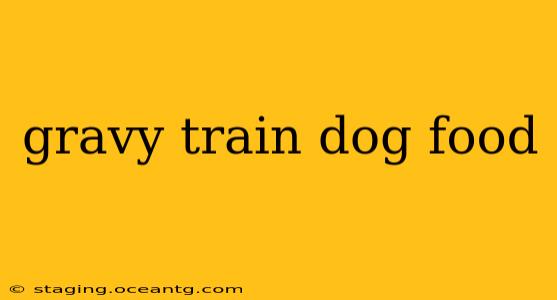Gravy Train dog food has been a familiar name in pet aisles for decades. But is it a good choice for your canine companion? This comprehensive review delves into the ingredients, nutritional value, potential drawbacks, and overall suitability of Gravy Train for different dogs. We'll also address some frequently asked questions to provide you with a complete picture.
Is Gravy Train Dog Food Good for My Dog?
This is the million-dollar question, and the answer isn't a simple yes or no. Gravy Train occupies a specific niche in the dog food market: it's an affordable, widely available option. However, its nutritional profile differs significantly from premium brands. While it may meet minimum nutritional requirements, it often falls short in terms of high-quality protein sources, fiber content, and overall ingredient quality. Whether it's "good" depends entirely on your dog's individual needs, your budget, and your priorities for their health.
What are the Ingredients in Gravy Train Dog Food?
Gravy Train's ingredient list varies slightly depending on the specific flavor and formula (e.g., puppy, adult, senior). However, common ingredients usually include corn, meat by-products, poultry by-products, wheat, and soy. These are often less expensive than higher-quality protein sources like chicken, lamb, or fish. The presence of fillers like corn and wheat can also lead to less digestible food, potentially resulting in loose stools or less satiety for your dog.
Does Gravy Train Dog Food Contain Artificial Preservatives?
Many formulations of Gravy Train dog food do contain artificial preservatives, colors, and flavors. While these are generally considered safe within regulatory limits, some pet owners prefer to avoid them due to concerns about potential long-term health effects. Always check the specific ingredient list on the packaging for detailed information.
How Does Gravy Train Compare to Other Dog Foods?
Compared to premium dog foods, Gravy Train often falls short in several areas. Premium brands typically use higher-quality protein sources, more easily digestible carbohydrates, and fewer fillers. They also tend to have a higher concentration of essential nutrients and vitamins tailored to a dog's specific life stage. However, Gravy Train's affordability makes it accessible to a wider range of pet owners.
Is Gravy Train Dog Food Good for Puppies?
Gravy Train offers puppy formulations, but many veterinary nutritionists recommend choosing puppy food with higher-quality protein and fat content for optimal growth and development. Puppies have unique nutritional requirements, and a lower-quality food may not adequately support their rapidly growing bodies. Consider a puppy food specifically designed to meet their higher energy demands and nutritional needs.
Is Gravy Train Dog Food Good for Senior Dogs?
Similarly, senior dogs have different nutritional needs compared to adult dogs. Senior formulations of Gravy Train may contain adjusted levels of certain nutrients, but premium senior dog foods often provide better support for aging dogs, including joint health, cognitive function, and digestive health.
Is Gravy Train a Complete and Balanced Food?
Gravy Train is formulated to meet the Association of American Feed Control Officials (AAFCO) minimum nutritional requirements for adult maintenance. However, "complete and balanced" doesn't automatically equate to optimal nutrition. The quality and bioavailability of nutrients are crucial factors. A diet based solely on Gravy Train may not provide the optimal level of specific nutrients for all dogs, especially those with specific health conditions or higher activity levels.
What are the potential drawbacks of feeding my dog Gravy Train?
Potential drawbacks of feeding Gravy Train include lower digestibility, potentially leading to more frequent bowel movements or looser stools. The reliance on fillers might mean your dog doesn't feel as full after eating, potentially leading to increased food intake and weight gain. Also, the lower quality protein sources might not be as efficiently utilized by the dog's body.
Disclaimer: This information is for educational purposes only and should not be considered a substitute for professional veterinary advice. Always consult with your veterinarian to determine the best diet for your individual dog's needs and health status.
